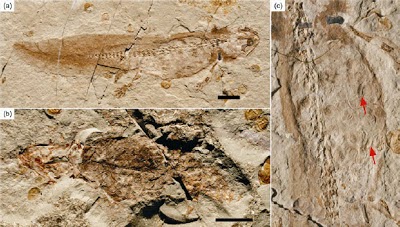Salamanders, Caudata, are one of the three extant groups of
Lisamphibians, along with Frogs, Anura, and Caecilians, Gymnophiona. The earliest fossil
Salamanders known date from the Middle Jurassic, and include both crown group
Salamanders (all living Salamanders, their most recent common ancestor, and
everything descended from that ancestor) and stem group Salamanders (Salamanders
which lived before the most recent common ancestor of all living Salamanders,
or which are descended from such Salamanders but not the most recent common
ancestor), suggesting that more-or-less modern forms appeared very early in the
history of the group. The crown group Salamanders quickly become dominant in
the fossil record, with only one report of Cretaceous stem group Salamanders,
based upon isolated vertebrae from the Cloverly Formation of Wyoming.
In a forthcoming paper in the journal Acta Palaeontologica Polonica
available online from 28 November 2014, Pavel Skutschas of the Vertebrate
Zoology Department at Saint Petersburg State University and the Laboratory of
Mesozoic and Cenozoic Continental Ecosystems at Tomsk State University
describes a possible stem group Salamander from the Ilek Formation of Western
Siberia.
The specimen comprises a single fragmentary trunk vertebra, which Skutschas
does not name, but which he feels is likely to represent a stem group
Salamander as it has a notochordal centrum (a
common feature to all Lisamphibians), is longer than it is wide (seen in all
Salamanders and no Frogs), lacks the extra muscle attachments seen in Caecilians,
is far larger than any known Mesozoic crown group Salamander (all of which were
quite small, the modern Giant Salamanders having appeared later) is heavily
ossified (again not seen in Mesozoic crown group Salamanders) and has scattered
pits on its ventral and lateral surfaces (a feature seen in some other stem
group Salamanders but not in any known crown group Salamander).
Fragmentary trunk vertebral centrum of stem salamander
Caudata, from the Shestakovo locality, Lower Cretaceous (Aptian–Albian) Ilek
Formation, Western Siberia, Russia; in right lateral (A), left lateral (B), ventral
(C, anterior towards top), posterior (D), anterior (E), and dorsal (F, anterior
towards top) views. Photographs (A1–C1, D–F) and
interpretive drawings (A2–C2). All images at same scale. Skutschas
(2014).
The Ilek Formation of Western Siberia has yielded a variety of other
relict vertebrates with Jurassic affinities, including Choristoderes,
Paramacellodid Lizards, Tritylodonts, Docodont Cynodonts and Protosuchian and
Shartegosuchid Crocodyliforms. Skutschas suggests that environmental conditions
in Western Siberia remained constant and stable across the Jurassic-Cretaceous
boundary, and that the area therefore provided a refugia for vertebrate groups
that went extinct elsewhere.
See also…
Paedomorphisis is a pattern of developmental change in which an organism
evolves to retain juvenile traits into its adult, sexually mature
stage. This is a recurring evolutionary pattern in some groups of
animals, with different but related lineages often separately developing
the same traits in this way. One such group is the Lungless Salamanders
(Plethodontidae), a group...
Newts, Pleurodelinae, are small members of the...
The Daohugou Beds are a fossil Lagarstätte from Ningcheng County in
Inner Mongolia, which have produced a large number of well preserved
Middle Jurassic Vertebrates, Insects, Plants and other fossils...
Follow Sciency Thoughts on Facebook.




